- There are no more items in your cart
- Shipping Calculated at checkout
-
Sub-Total (inc. VAT)
£0.00
Need Help?
Thermoplastic Lines and Road Marking
The perfect solution to permanently marking asphalt or concrete, thermoplastic line markings are hard wearing, quick and easily applied at any time of the year with a propane heat torch requiring only one operative. Our range of precision clean cut, crisp line markings are made from non-cracking, tough thermoplastic for excellent cost effectiveness and long-term performance in car parks, roads, cycleways, airports, docks and playgrounds etc, with symbols for identifying disabled bays, cycle paths, etc.
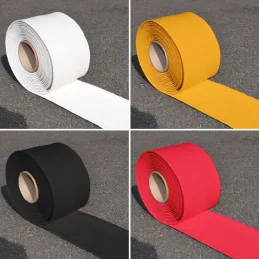
Swarco Hitex Preformed Eco Thermoplastic Lines
Pre-formed thermoplastic lines that are fast and convenient to install, with excellent adhesion, durability, flow and colour stability. Previously known as Hitex Hiflex Preformed Suitable for: Reinstatement of markings following utility works Fast and simple installation of new letters / numbers / symbols Small scale lining work such...
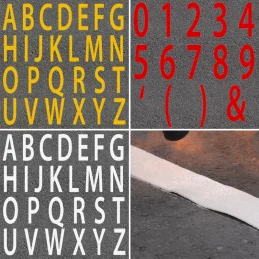
Swarco Hitex Preformed Eco Thermoplastic Letters and Numbers
Fast and convenient to install, with excellent adhesion, durability, flow and colour stability. Suitable for: Reinstatement of markings following utility works. Fast and simple installation of new letters / numbers / symbols. Small scale lining work such as car parks. School playground educational markings. Company logos. Safe route...
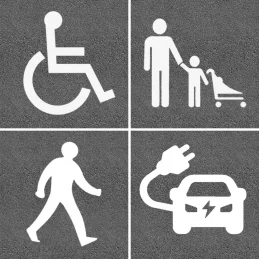
Swarco Hitex Preformed Eco Thermoplastic Symbols
Pre-formed thermoplastic symbols that are fast and convenient to install, with excellent adhesion, durability, flow and colour stability. See ordering references below. Previously known as Hitex Hiflex Preformed Suitable for: Reinstatement of markings following utility works Fast and simple installation of new letters / numbers /...
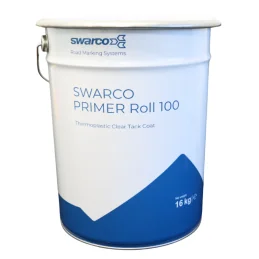
Swarco Hitex Primer Roll 100
A clear liquid tack coat primer designed for the adhesion of thermoplastic road markings onto bituminous and non-bituminous substrates. HT Primer is an easy to apply, low viscosity, colourless liquid tack coat primer. Previously known as Hitex HT Adhesion Primer The use of HT Primer with Hitex thermoplastic markings is strongly recommended...
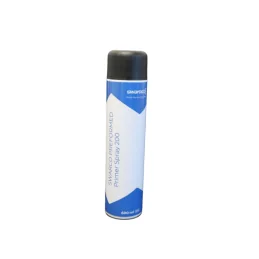
Swarco Hitex Preformed Primer Spray 200
A clear aerosol spray primer designed for the adhesion of thermoplastic road markings onto bituminous and non-bituminous substrates. Swarco Preformed Primer Spray 200 (previously known as Hitex HiTack Primer) is an easy to apply, colourless aerosol spray tack coat primer. The use of Swarco Preformed Primer Spray 200 with Swarco Hitex...
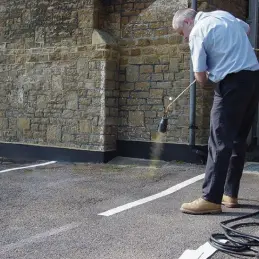
Watco Thermoline Lines & Symbols
Preformed long-lasting lines and symbols for heavy traffic areas such as roads and warehouse floors. Tough, flexible and permanent No cutting required Quick application Areas of use include: Roadways Warehouses Pavements Car parks Playgrounds More Information Delivery Info
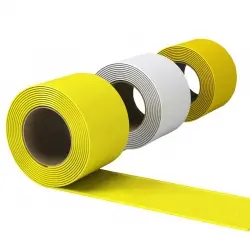
Instarmac UltraCrete Instaline Thermoplastic Road Marking
Instaline is ideal for the reinstatement of line areas on car parks, roads and carriageways. This thermoplastic road marking provides anti-skid, is reflective and easy to apply. Conforms to BS EN 1436:2007 as a road marking material Remains flexible and easy to un-roll in temperatures as low as 5°C No waste, cut as required Please note:...
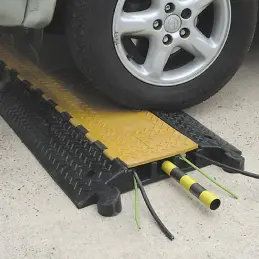
Watco Heavy Duty Cable Protector
Heavy duty interlocking protection for your industrial cables. Withstands heavy traffic No ground fixings usually required Anti slip hinged top panel Three panels for cabling More Information Delivery Info
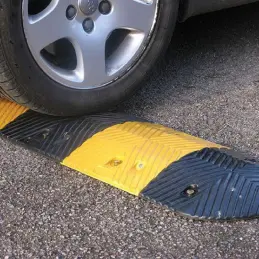
Watco Compact Speed Bumps
A cost effective solution for increasing safety in car parks. Suitable for concrete and asphalt road surfaces and available in 500mm wide segments to suit any road width. Slows traffic to 10mph Withstands 40 tonne HGVs Fixings supplied Can be seen in the dark More Information Delivery Info
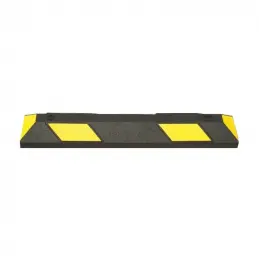
Watco Parking Bumpers
Offer protection against accidents in car parking areas. Made from recycled rubber, they are resistant to grease and acids, and can withstand temperatures of -40°C to 80°C. Highly visable even at night with reflective panels For use in car parks or to separate traffic routes, vehicular traffic and pedestrian paths Available in 2 sizes:...
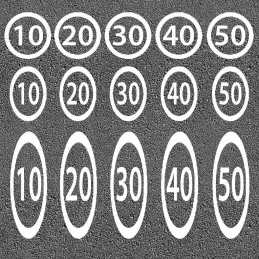
Swarco Hitex Preformed Eco Thermoplastic Road Markings
Pre-formed thermoplastic road markings that are fast and convenient to install, with excellent adhesion, durability, flow and colour stability. More Information Delivery Info See More Thermoplastic Symbols & Lines

Swarco Hitex Preformed Eco Thermoplastic Car Charging Symbols
Pre-formed thermoplastic symbols that are fast and convenient to install, with excellent adhesion, durability, flow and colour stability. 9 designs available, in 4 sizes from 800mm to 1400mm, and mutliple colours More Information Delivery Info See More Thermoplastic Symbols & Lines
Need Help?
Need Help?
Thermoplastic road marking products are a superior solution for creating long-lasting, highly visible lines on various surfaces, such as highways, car parks, pedestrian zones, and industrial flooring. Also known as "Thermoplastic Striping", these materials are applied in molten form, which allows them to bond securely to the surface, ensuring maximum adhesion and durability. Once set, thermoplastic markings are resistant to weather conditions, abrasions, and chemical spills, making them ideal for high-traffic areas.
In addition to their robust performance, thermoplastic markings often contain reflective glass beads, which provide enhanced visibility at night and in adverse weather conditions. These markings are designed to withstand continuous wear, ensuring they remain clear and effective even in areas subject to heavy use. With a lifespan that significantly exceeds other marking solutions, thermoplastic materials are trusted for critical applications where safety and visibility are paramount.
Top Features and Benefits of Thermoplastic Road Marking
Thermoplastic road marking products offer several features and benefits that set them apart from traditional paints and other marking solutions.
Durability and Longevity
Thermoplastic materials provide a robust, hard-wearing finish that can last for years. Unlike conventional paint, thermoplastic is resistant to fading, cracking, and peeling. This is particularly important in areas exposed to constant traffic, harsh weather, and chemical spills.
Quick Application and Fast Drying
One of the standout features of thermoplastic markings is their quick application process. The material is heated to a high temperature and applied to the surface in a molten state, which allows it to bond securely. Once applied, it cools and sets rapidly, minimising downtime and traffic disruption.
Enhanced Visibility
The addition of reflective glass beads during the application process provides excellent retro-reflectivity, improving visibility at night or in low-light conditions. This feature is crucial for maintaining road safety, especially on highways and in poorly lit areas.
Weather and Wear Resistance
Thermoplastic markings are highly resistant to a wide range of environmental factors, including UV radiation, rain, snow, and extreme temperatures. Their resilience makes them suitable for use in all climates, from icy motorways to hot urban streets.
Cost-Effective Solution
While thermoplastic marking materials may have a higher upfront cost compared to traditional paint, their durability and longevity make them a more cost-effective solution over time. Fewer reapplications are needed, reducing the long-term cost of road maintenance.
Skid Resistance
Thermoplastic road markings can be formulated to include anti-skid aggregates, improving traction for vehicles and pedestrians. This feature enhances safety, particularly in areas where sharp turns, sudden stops, or pedestrian crossings are frequent.
Versatility in Application
Thermoplastic can be used on a variety of surfaces, including asphalt, concrete, and cobblestone. It is not limited to roads; it is also commonly used in car parks, pedestrian walkways, airport runways, and industrial sites where clear, long-lasting markings are essential.
Compliance with Safety Standards
Many thermoplastic products meet or exceed local and international safety regulations, including those governing road visibility and anti-skid properties. This makes them a reliable choice for contractors and government agencies seeking to ensure compliance in road marking projects.
Low Maintenance
Once applied, thermoplastic markings require minimal maintenance. Their resistance to wear, weather, and chemicals ensures they stay intact for longer, reducing the need for frequent touch-ups or replacements.
Eco-Friendly Options
Many thermoplastic marking materials are now available in environmentally friendly formulations. These products offer low VOC emissions and are free from harmful substances, making them a more sustainable option for infrastructure projects.
Common Uses of Thermoplastic Lines and Market Sectors
Thermoplastic line marking is one of the most versatile and durable options for a range of applications across various industries. Below is a closer look at the extensive uses of thermoplastic markings, how they enhance safety, and the industries that benefit from their application.
Highways and Motorways
Thermoplastic markings are vital for ensuring safe navigation on busy highways and motorways. They are used to delineate lanes, borders, and junctions, creating a clear visual guide for drivers. Their reflective properties improve night-time visibility, and the skid-resistant texture can help prevent accidents on tight curves or during wet weather. These markings are a key safety feature on roads and are used for everything from lane separation to hazard warnings.
Highways require markings that can withstand continuous high-speed traffic, harsh weather conditions, and occasional impact from vehicles. Thermoplastic’s resistance to wear makes it the preferred choice for road authorities tasked with keeping motorways clearly marked and safe over the long term.
Urban Roads and Pedestrian Zones
Within cities and towns, thermoplastic markings are commonly used to create pedestrian crossings, cycle lanes, and bus lanes. As urban areas see heavy foot and vehicle traffic, these markings are essential for both vehicle management and pedestrian safety. Reflective glass beads incorporated into the markings make crosswalks highly visible at night or in poor weather, and anti-slip features protect pedestrians from falls.
In addition, thermoplastic lines are often used to mark no-parking zones, speed-restriction areas, and designated lanes for buses and taxis, all of which help maintain smooth and organised traffic flow in congested urban environments.
Car Parks and Retail Complexes
Thermoplastic lines are frequently used in car parks to mark parking bays, traffic flow directions, and pedestrian paths. The heavy usage in commercial and retail spaces means that markings must be durable enough to withstand vehicle movement, frequent foot traffic, and exposure to various weather conditions. Thermoplastic markings maintain their clarity and colour even after years of use, reducing the need for reapplication and improving safety by keeping markings visible.
Large retail complexes and shopping centres rely on thermoplastic markings to manage parking space allocation, disabled parking spots, and emergency access areas, ensuring compliance with local regulations and enhancing visitor experience.
Airports and Runways
In the aviation industry, thermoplastic markings play a crucial role in airfield safety and efficiency. Runways, taxiways, and apron areas use thermoplastic to mark essential zones for aircraft landing, takeoff, and movement. Given the critical nature of airfield operations, these markings must remain clearly visible at all times, especially at night or in poor weather. The durability and reflective qualities of thermoplastic materials ensure that pilots have the visual cues they need, even under challenging conditions.
Thermoplastic markings are also used in airport car parks, shuttle areas, and pedestrian walkways, ensuring that both passengers and ground vehicles move safely and efficiently around the facility.
Industrial and Warehouse Facilities
In industrial environments, thermoplastic markings are used to clearly define traffic lanes, pedestrian walkways, safety zones, and storage areas within large facilities. Factories and warehouses are often subject to heavy vehicle movement, forklifts, and foot traffic, making it essential to have clear, long-lasting markings that organise the space and reduce the risk of accidents.
Thermoplastic markings offer the durability needed to withstand the intense wear of industrial equipment and constant use, and their high visibility ensures that safety zones and hazard areas are easily identifiable by workers and vehicles alike.
Ports and Shipping Yards
Ports and shipping yards are high-traffic zones where both heavy machinery and personnel must work in close proximity. Thermoplastic markings provide essential guidance for vehicle lanes, loading zones, and pedestrian safety areas. In such facilities, markings must endure harsh weather conditions, exposure to saltwater, and continuous loading and unloading operations. Thermoplastic’s long-lasting properties and resistance to these elements make it ideal for this demanding environment.
School and Hospital Grounds
Educational and healthcare facilities often use thermoplastic markings for car parks, pedestrian pathways, and emergency vehicle lanes. In schools, playgrounds, and sports areas, thermoplastic markings are used to create safe zones and game courts, benefiting from the material’s long-lasting durability and skid resistance. Hospitals also rely on thermoplastic lines for parking, ambulance bays, and designated drop-off zones, ensuring quick and easy navigation during emergencies.
Public Transport Hubs and Railways
At bus stations, train stations, and metro hubs, thermoplastic markings are widely used to manage pedestrian traffic, designate bus lanes, and mark areas for vehicle movement. The durability of thermoplastic ensures that these high-use areas remain clearly marked, even with constant footfall and vehicle wear. Thermoplastic’s reflective properties are particularly beneficial in low-light stations and night-time operations, enhancing safety for passengers.
Sports Facilities and Recreational Areas
From playgrounds and parks to football pitches and tennis courts, thermoplastic markings are used to mark boundaries, game areas, and pedestrian walkways. The ability of thermoplastic to maintain vibrant colours and resist weathering ensures that sports courts and recreational spaces remain clearly defined and safe for long-term use.
In addition, thermoplastic can be used for custom designs in playgrounds, offering flexibility for creating games, markings, and safe areas where children can play without risk of slips or accidents.
Maritime and Coastal Infrastructure
Thermoplastic markings are suitable for coastal roads, dockyards, and seafront car parks. The maritime industry often requires markings that can withstand exposure to salty air, water, and harsh weather conditions. Thermoplastic's durability and chemical resistance make it ideal for maritime and coastal applications where long-term resilience is critical.
For assistance with product selection and compatibility, contact the technical support team.
Frequently Asked Questions (FAQs)
Can thermoplastic road markings be applied in wet conditions?
No, thermoplastic road markings require a dry surface for proper adhesion. Any moisture on the surface can prevent the material from bonding securely, leading to premature wear or peeling. It is recommended to ensure the surface is dry and clean before application, particularly after rain or during humid conditions.
How long does it take for thermoplastic road markings to fully set?
Thermoplastic markings cool and set within a few minutes of application, allowing traffic to return to the area quickly. However, it’s best to wait for the markings to cool completely before allowing vehicles or pedestrians to cross, usually around 5 to 10 minutes, depending on the temperature and weather conditions.
Are thermoplastic markings suitable for temporary road markings?
While thermoplastic markings are highly durable, they are generally not intended for temporary applications. Paint or tape-based solutions are often more suitable for short-term road marking needs as they are easier to remove after use. Thermoplastic is better for long-lasting, permanent markings.
Can thermoplastic markings be used on uneven or textured surfaces?
Yes, thermoplastic materials can be applied to uneven or textured surfaces such as cobblestones or rough concrete. The material’s molten state allows it to conform to the surface’s texture, although more care may be needed during application to ensure full coverage and adhesion on irregular surfaces.
How is thermoplastic road marking applied?
Thermoplastic road marking is applied by heating the material to its melting point (usually between 180-200°C) and then spreading it onto the surface using specialised equipment. The material solidifies as it cools, bonding firmly with the surface. Reflective glass beads can be added during or after application to enhance visibility.
Are there different colours available for thermoplastic markings?
Yes, thermoplastic markings are available in a wide range of colours, including white, yellow, blue, red, and green. The colour chosen typically depends on the specific use, such as white for lane markings, yellow for no-parking zones, and blue for disabled parking bays. Custom colours can also be produced for specific projects.
Can thermoplastic markings be applied over old markings?
Yes, thermoplastic can be applied over old markings, but the surface must first be prepared by cleaning and removing any loose or flaking material. In some cases, a primer may be required to ensure the new thermoplastic layer adheres properly to the existing markings.
Are thermoplastic markings resistant to oil spills and chemicals?
Thermoplastic markings are highly resistant to oil, petrol, and most common chemicals, making them ideal for use in industrial areas, car parks, and petrol stations where chemical exposure is common. Their durability ensures that spills do not degrade the markings or reduce their visibility.
What maintenance is required for thermoplastic road markings?
Thermoplastic markings require minimal maintenance due to their durability. However, over time, they may need periodic cleaning to remove dirt and debris, especially in high-traffic areas. In some cases, reapplication may be needed if the markings become worn, particularly in areas with heavy vehicle movement.
How does thermoplastic compare to cold-applied plastic road markings?
Both thermoplastic and cold-applied plastic offer durability and high visibility. However, thermoplastic is preferred for larger, more permanent applications due to its longer lifespan and faster setting time. Cold-applied plastic is often used for smaller jobs or areas where a quick, low-temperature application is needed, but it generally does not last as long as thermoplastic.
